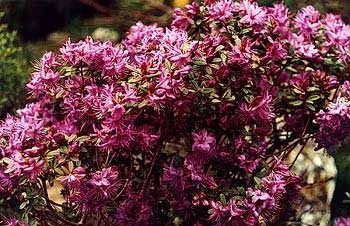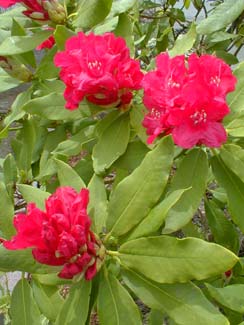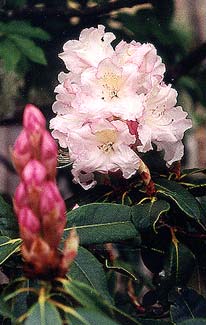 | |
| For some gardeners it's just not possible to change the fact that one's yard receives an awful lot of sunlight. It doesn't mean rhododendrons are out of the question. Dwarf rhododendrons such as this R. yungningense prefer a good bit of sunshine. Some larger varieties are also sun-tolerant, & a few actually prefer sun. | |
About Rhododendrons & Sun Tolerance
It is commonly said that rhododendrons are shade plants. But really the majority want dappled sunlight or half-shade & half-sun. A surprising number of rhodies actually prefer & do better in direct sunlight. I'm speaking of Puget Sound (USDA zone 8, Sunset zone 5). Sun tolerance will never be strong in the hottest states, but in many zones, with careful selection, it is definitely possible to create a rhododendron garden even in a yard that receives full morning sun or full afternoon sun, up to as much six hours a day before it becomes a real struggle.
How to select sun-tolerant rhodies? As a generality with exceptions, dwarf rhodies that reach only 3 feet in ten years want a sunny spot & will bloom poorly in shade. By contrast, big-leafed rhododendrons which exceed six feet want the dappled shade with only a little sun, though the exceptions here are quite numerous. Although it tends to be true that small-leaf varieties tolerate more sun than big-leaf, there are big-leafed Iron Clads that also tolerate sun, so leaf size isn't quite as good a general gauge as dwarf or semi-dwarf.
A little hillside with lots of sun-loving dwarf rhodies can be a splendid thing to see. Or for a mix of sizes including some that are not sun tolerant. A gardener could first install, say, one substantial Japanese maple. Then there could be some mid-sized big-leaf rhododendrons near the maple where they will grow up together, the maple always ahead of the rhodies in size providing dappled shade. Plus the dwarf rhodies can placed farther from the maple where shade doesn't fall.
Here's a starter-list for selecting sun-tolerant rhodies:
- Large deciduous azaleas are as a generality very adaptable to sunnier yards. R. calendulaceum, the Flame Azalea, is a large native species which prefers full sun. R. serrulatum, Swamp Azalea, also loves the sun just so long as its feet are never completely dry. Many other species of large deciduous azaleas will be at least tolerate sun, even if dappled shade/sun would have been slightly better. We have R. occidentale x calendulaceum in a full sun location where it thrives, though its blooms are exhausted sooner than if it had more shade (in time, as nearby maple & hornbeam trees continue to grow, this azalea will get decreasingly extreme sun exposure). Our large Whitethroat Azalea hugely likes its full morning sun exposure, but if it were getting both morning & afternoon exposure, that'd be overdoing it.

- "Iron Clads" or Catawbas (hybrids mostly derived from an American species, R. catawbiense) are big-leafed varieties bred for winter hardiness. Most prefer dappled sunlight, but quite a number of them are in fact sun tolerant (but check specifics for each cultivar before assuming any given Iron Clad will do well in sun). They are among the most common offerings with scores of cultivars, but unfortunately they're rarely labeled for easy recognition as iron clads, so you have to have a rhody book to hand to check while in the nurseries. Such rhodies may be listed as Elepidotes, Catawbas, or Iron Clads. When gardeners discover that rhodies do bloom better in sunlight despite that leafscald is a risk, they are usually speaking of Iron Clads whether they know it or not, since it isn't true of the more sensitive large-leaf rhodies the blooms of which fade, shrivel, & darken in direct sunlight. One of the most sun-hardy of all the sun-hardy Iron Clads is Jean Marie de Montague, shown here at the right in a May portrait. Another one although not as famously sun-tolerant is Anna Rose Whitney we have in a full afternoon sun location, where it has never shown the least sign of stress. We also placed Blue Peter & Nova Zembla in full direct sunlight, under the assumption that these old garden standards were most adaptable, & they've done superbly. The one proviso is all of these do have companion shrubs or young trees nearby, which function as windbreaks, as winter winds can be more harmful than an extra bit of sunlight.
- PJMs are famously adaptable shrubs with mahagony leaf color in winter. This group of cultivars include some that are nearly dwarf, but most can reach six feet or taller, though they grow slowly. They prefer more sun than most rhodies & won't achieve maximum winter leaf-color in shade.
 "Carolina rhododendrons" are also Iron Clads but are small leaf in contrast to the Catawbas with larger leaves, though they are crossed with one another so often leafsize doesn't always define them. These are derived from the native R. carolinianum. A very high percentage of these will actually prefer full sun, though roots should never dry out. In a burning summer, or in windy winter sun, they might suffer leaf scald or desication if totally unprotected, but even so, they'll bloom better than in shadier locations. R. c. 'Dora Amateis' is typical of the small-leaf Carolina hybrids & it definitely does best in full sun. It develops interesting leaf coloration in sun that it lacks in shade. Sort of mid-dwarf, not totally small, can be 4 or 5 feet high high.
"Carolina rhododendrons" are also Iron Clads but are small leaf in contrast to the Catawbas with larger leaves, though they are crossed with one another so often leafsize doesn't always define them. These are derived from the native R. carolinianum. A very high percentage of these will actually prefer full sun, though roots should never dry out. In a burning summer, or in windy winter sun, they might suffer leaf scald or desication if totally unprotected, but even so, they'll bloom better than in shadier locations. R. c. 'Dora Amateis' is typical of the small-leaf Carolina hybrids & it definitely does best in full sun. It develops interesting leaf coloration in sun that it lacks in shade. Sort of mid-dwarf, not totally small, can be 4 or 5 feet high high.
- The beautiful large Loderi hybrids are almost never sun-tolerant with one gorgeous exception, 'Loder's White.' Its bloom & bud are shown here at the right as photographed in early May.
- A whole series of Polly Hill's dwarfs reach 3 feet & are very round, compact, & "big appearing" despite being so short, & the majority do want sunlight. Polly Hill small-leaf hybrids are more expected to be sun-tolerant, but 'Hill's Bright Red' is typical of the ones that have a more substantial mid-sized leaf & look like scaled-down versions of larger varieties.Hill's Bright Red used to be a garden standard but by now may have been displaced in the marketplace by a later version that is also bright-bright red.
- "Species dwarfs" are where dwarf hybrids get their sun- & cold-tolerances. Several evergreen varieties of R. eriocarpum are called "Gumpo Azaleas" & do best in sun. R. dichroanthum, R. fastigiatum, R. letcherianum, R. lepidotum, R. leucaspis, R. litangense, R. nakaharae, R. poukhanense, R. rupicola, R. russatum, R. williamsianum & most of the dwarf species from Tibet & China tend to prefer bright sun & very well-drained soils, although being adapted to alpine & subarctic direct sun, this doesn't always translate into heat resistance; rather, it means that in temperate zones they can or even shoud go in sunnier locations, but if temperatures are too high, emergency summer mulching will be needed to protect the roots.
- "Large species rhodies" are not usually as sun-tolerant as dwarf species, but there certainly are exceptions. R. concinnum is relatively sun tolerant compared to most of the larger rhododendrons, so long as it doesn't simultaneously experience droughtiness. R. acteum genuinely prefers the sun but that one's still rather rare in the marketplace.
- Tropical & subtropical rhodies can be added to this list mainly as a footnote; they won't often be good gardening choices unless you live in palm tree country. Most of the sun-hardy dwarves are alpine species used to full sun exposures at high altitudes where there is considerable ultra violet radiation. But the sun-hardy larger rhodies include tropicals & subtropicals, most of which would need protection from cold in the north. R. hyperythrum of subtropical origin is very heat tolerant & new hybrids are being developed by southern growers that will do well even in South & Southwest gardens, within reason. It could turn out that crosses with R. hyperythrum will harden up even for San Diego weather, but would likely need some shade protection in southern California, though they would easily take full sun in humid cloudy Florida. Depending on what it is crossed with, such hybrids may still be suitable to temperate zones. Subtropicals are most adaptable; the true tropicals might have trouble outside of a greenhouse except in the most humid warm states. Fully tropical rhodies often grow under rainforest trees, yet even so are adapted to high exposures of ultra violet radiation thus are hardy in sun. Tropical Vireya Rhododendrons (some are dwarf, some are quite big) occasionally become epiphytic in order to get closer to sunlight & have been found growing in the crowns of treeferns, though they prefer to grow on the ground if they can get enough sunlight. I've not grown such tropical-climate varieties & won't hazard guessing how they would behave in gardens, but they're certainly worth looking into as sun-loving possibilities.
Zone 7 or 8 is ideal for the majority of rhodies. If perfect dappeled shade conditions cannot be provided for the least sun-tolerant rhodies, it is easy in such a mild climate to get lucky even so, if all other conditions are excellent. For instance, if you select plants hardy to, say, Zone 4, they are not going to be at all stressed in temperate Zone 8, hence will very likely adapt to "one stress factor" such as a more hours of sun than is ideal. Two stress factors might overdo it, such as bright sun plus windiness, which would be enough to defeat even hardy PJMs. But if you get something recommended primarily for zone 7-8, these will be hardy mainly in their ideal dappled-shade situations, having less survival capacity outside their preferred zone hence less capacity outside their preferred conditions within that zone.
One problem even with sun-lovers in a totally temperate & expecially in a warmer climate is the most cold-hardy specimens (which tend also to be sun-tolerant) may find themselves trying to be actively growing in late fall & in winter when they really must be dormant. Bright sun warming the soil will fool them into thinking it's spring, then a cold snap could do them considerable harm. So winter sun's key threat is more to the root than to the leaves, but if you mulch to protect the roots, these shrubs will remain properly dormant. The group least to worry about in this regard are PJMs which can do their dormancy thing even in a pretty warm winter, then bloom as early as January & certainly by March.
A sunny location may mean you have to water rhodies winter as well as summer. The soil should never be dried out entirely. Rhodies like soil to be as much as 50% organic matter (compost, leaves, woodchips) but since the root is shallow this only means a working of the top ten or twelve inches of soil, & this will help maintain the degree of persisting moistness that'll be even more essential in sun-exposed rhodies.
Mulching is not radically important here on Puget Sound because winters are so mild, & topcoats of manure, or scattering autumn leaf-fall from the trees toward the rhodies where tree leaves will act as mulch & slowly turn into nutritious leafmold — these simple techniques are usually sufficient in temperate climates. Even with no mulching or topcoating at all, groundcover plants that are evergreen through winter will protect rhody roots sufficiently. Lily grasses including grape hyacinths which grow in autumn are evergreen through the winter then bloom early spring, & hardy cyclamens can get quite fluffily protective of the soil underneath evergreen rhodies & will bloom in winter (but cyclmens will get winter sun damaged under deciduous azaleas). Smaller plants as groundcover is certainly sufficient in dappled shade, but for rhodies in sunny locations you'll have to judge whether winter sun will be apt to warm the surface & so require good & complete mulching. Mostly mulching is to protect from freezing, but in really mild winters in locations of direct sun, it protects from prematurely inducing spring activity. Summer mulching may also be required if soils are too much warmed, though compactly leafed shrubs will usually provide sufficient shade to their own roots in summer.
When rhodies are three years in the ground they become increasingly tolerant of imperfect conditions; so anything that doesn't like the sunny spot you will know probably in the second year, & can decide whether to move any struggling specimens to a less sunny spot. The root is shallow & slow to spread, & the shrubs themselves grow slowly, so in the second or even third year you really can move them easily without much shock. If you do have an ideal location to move the few that turn out to be too sensitive for six hours of sun, then it's worth trying even the more sensitive varieties since you can move them if sun isn't working out.
You'll also find, if you go to a large enough nursery with lots of rhody choices, that tags are nowadays pretty informative as to sun tolerance. I'm seeing more & more varieties labeled "Sun to part shade" rather than just part shade. Sun tolerance is a trait gardeners have wanted & there are by now so many choices it'll soon be impossible to be sure shadier spots are best for most most rhodies.
Appended below are links to some of my pages about sun-tolerant & sun-preferring varieties of rhodies in our gardens. Our gardens are mainly dapple-shaded for large rhodies & sometimes our problem is finding a sunny enough spot such as the alpine dwarf varieties prefer. I will have more pages about sun-tolerant choices as time & successful photography permits:
R. concinnum
Girard's Crimson
Hill's Bright Red
The Honorable Jean Marie de Montague
Karin Seleger
Loder's White
Milestone
PJM Elite
Starry Night
Whisperingrose
R. yungingense